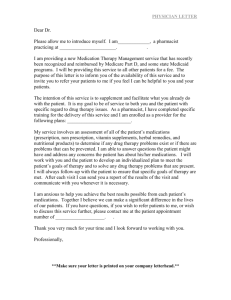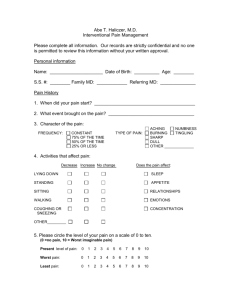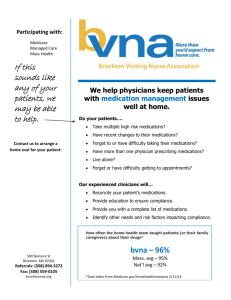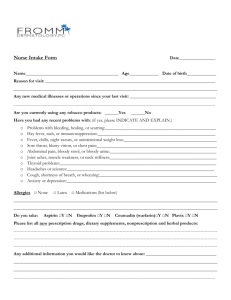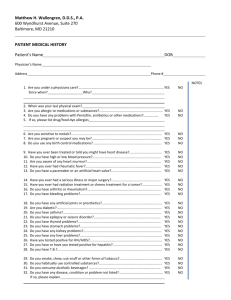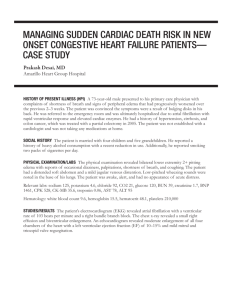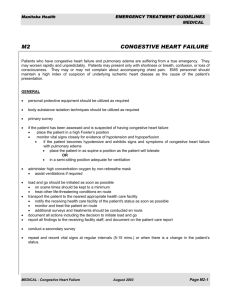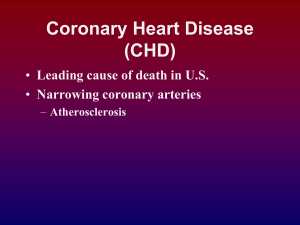Congestive Heart Failure - Texas Department of State Health Services
advertisement
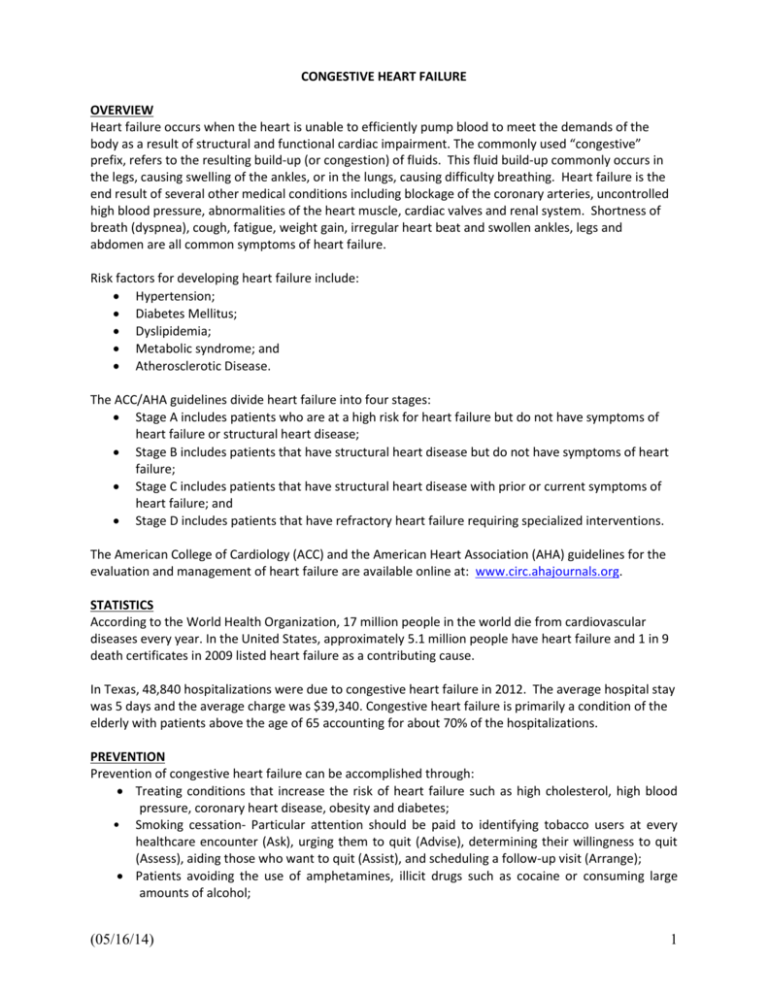
CONGESTIVE HEART FAILURE OVERVIEW Heart failure occurs when the heart is unable to efficiently pump blood to meet the demands of the body as a result of structural and functional cardiac impairment. The commonly used “congestive” prefix, refers to the resulting build-up (or congestion) of fluids. This fluid build-up commonly occurs in the legs, causing swelling of the ankles, or in the lungs, causing difficulty breathing. Heart failure is the end result of several other medical conditions including blockage of the coronary arteries, uncontrolled high blood pressure, abnormalities of the heart muscle, cardiac valves and renal system. Shortness of breath (dyspnea), cough, fatigue, weight gain, irregular heart beat and swollen ankles, legs and abdomen are all common symptoms of heart failure. Risk factors for developing heart failure include: Hypertension; Diabetes Mellitus; Dyslipidemia; Metabolic syndrome; and Atherosclerotic Disease. The ACC/AHA guidelines divide heart failure into four stages: Stage A includes patients who are at a high risk for heart failure but do not have symptoms of heart failure or structural heart disease; Stage B includes patients that have structural heart disease but do not have symptoms of heart failure; Stage C includes patients that have structural heart disease with prior or current symptoms of heart failure; and Stage D includes patients that have refractory heart failure requiring specialized interventions. The American College of Cardiology (ACC) and the American Heart Association (AHA) guidelines for the evaluation and management of heart failure are available online at: www.circ.ahajournals.org. STATISTICS According to the World Health Organization, 17 million people in the world die from cardiovascular diseases every year. In the United States, approximately 5.1 million people have heart failure and 1 in 9 death certificates in 2009 listed heart failure as a contributing cause. In Texas, 48,840 hospitalizations were due to congestive heart failure in 2012. The average hospital stay was 5 days and the average charge was $39,340. Congestive heart failure is primarily a condition of the elderly with patients above the age of 65 accounting for about 70% of the hospitalizations. PREVENTION Prevention of congestive heart failure can be accomplished through: Treating conditions that increase the risk of heart failure such as high cholesterol, high blood pressure, coronary heart disease, obesity and diabetes; • Smoking cessation- Particular attention should be paid to identifying tobacco users at every healthcare encounter (Ask), urging them to quit (Advise), determining their willingness to quit (Assess), aiding those who want to quit (Assist), and scheduling a follow-up visit (Arrange); Patients avoiding the use of amphetamines, illicit drugs such as cocaine or consuming large amounts of alcohol; (05/16/14) 1 Patients avoiding medications that have cardiotoxic side effects - examples include ephedra, steroids, herceptin among others; and Being physically active. TREATMENT The underlying cause and precipitating factors need to be addressed when treating heart failure. Treatment for heart failure is based on the ACC/AHA disease stages. The treatment in stage A is focused on modifying risk factors through diet and lifestyle modifications and the treatment/control of conditions that increase the risk of heart failure. In addition to stage A recommendations, the focus for stage B patients is on treating the structural heart disease while the goal for stages C and D is reducing morbidity and mortality. The guidelines recommend ACE inhibitors, ARB’s, beta blockers, digoxin and aldosterone receptor antagonists for the treatment of heart failure. Hydralazine and isosorbide dinitrate are recommended specifically for use in African American patients. ACE inhibitors have been shown to reduce hospitalizations as well as morbidity and mortality in heart failure patients. ARB’s are used in patients who cannot tolerate ACE inhibitors while diuretics are used in patients who have fluid retention. Medications should be titrated slowly and in small increments with vital signs being monitored closely during titration especially in the elderly. Treatment options for stage D patients include heart transplants, experimental surgery and temporary or permanent mechanical circulatory support. Please refer to the ACCF/AHA Guideline for specific treatment information. REDUCING REHOSPITALIZATIONS Some of the ways that heart failure hospitalizations/rehospitalizations can be reduced include: Following evidence based guidelines when treating heart failure patients; Patients being physically active - exercise in patients that have heart failure improves cardiac function; Setting up appropriate follow up care- the guidelines recommend follow up visits within 7 to 14 days and/or a telephone follow-up within 3 days of hospital discharge; Discontinuing medications that exacerbate heart failure - these medications include NSAID’s, thiazolidinedione’s, most calcium channel blockers and antiarrhythmic drugs; Educating the patient, family members and caregivers on how to identify symptoms of worsening heart failure, adverse effects of prescribed medications and how to monitor weight fluctuations; Medication adherence; If available, enrolling patient in a disease management program; Restricting patients' sodium, alcohol and fluid intake - sodium intake should be restricted to 1500 mg/day in most patients with stage A and B heart failure; Referring patients to cardiac rehabilitation if appropriate - cardiac rehabilitation has been shown to improve functionality capacity and reduce mortality; and Administering pneumococcal pneumonia and influenza vaccinations - the flu and pneumonia can worsen heart failure. RESOURCES Call 2-1-1 or visit www.211texas.org to find information about resources in your local community Medication adherence - talk to your doctor or pharmacist about any concerns or questions you might have regarding your medications. (05/16/14) 2 References: 1. Heart Failure Fact Sheet. Center of Disease Control and Prevention. Available at: http://www.cdc.gov/dhdsp/data_statistics/fact_sheets/fs_heart_failure.htm. Reviewed December 3, 2013. Accessed March 22, 2014. 2. Heart failure overview. National Institute of Health. Available at: http://www.nlm.nih.gov/medlineplus/ency/article/000158.htm. Updated: February 26, 2014. Accessed March 1, 2014. 3. Go, AS, Mozaffarian, D, Roger, VL, Benjamin, EJ, Berry, JD, et al. Heart disease and stroke statistics—2013 update: a report from the American Heart Association . Circulation. 2013; 127:e6–e245. 4. Karon, B. Heart failure. In: Habermann, T, Ghosh, A, editors. Mayo clinic internal medicine. Boca Raton (FL): CRC Press; 2013. P. 109-110. 5. The Atlas of Heart Disease and Stroke. World Health Organization. Available at: http://www.who.int/cardiovascular_diseases/resources/atlas/en/. Accessed March 1, 2014. 6. Yancy CW, Jessup M, Bozkurt B, et al. 2013 ACCF/AHA guideline for the management of heart failure: a report of the American College of Cardiology Foundation/American Heart Association Task Force on Practice Guidelines. J Am Coll Cardiol. 2013 Oct 15;62(16):e147-239 (05/16/14) 3


